Greenhouse ideas – 19 glasshouse design tips for gardens of all sizes
Create the perfect growing space under glass with these greenhouse ideas for gardens large and small, and nurture tender and exotic plants and crops year round
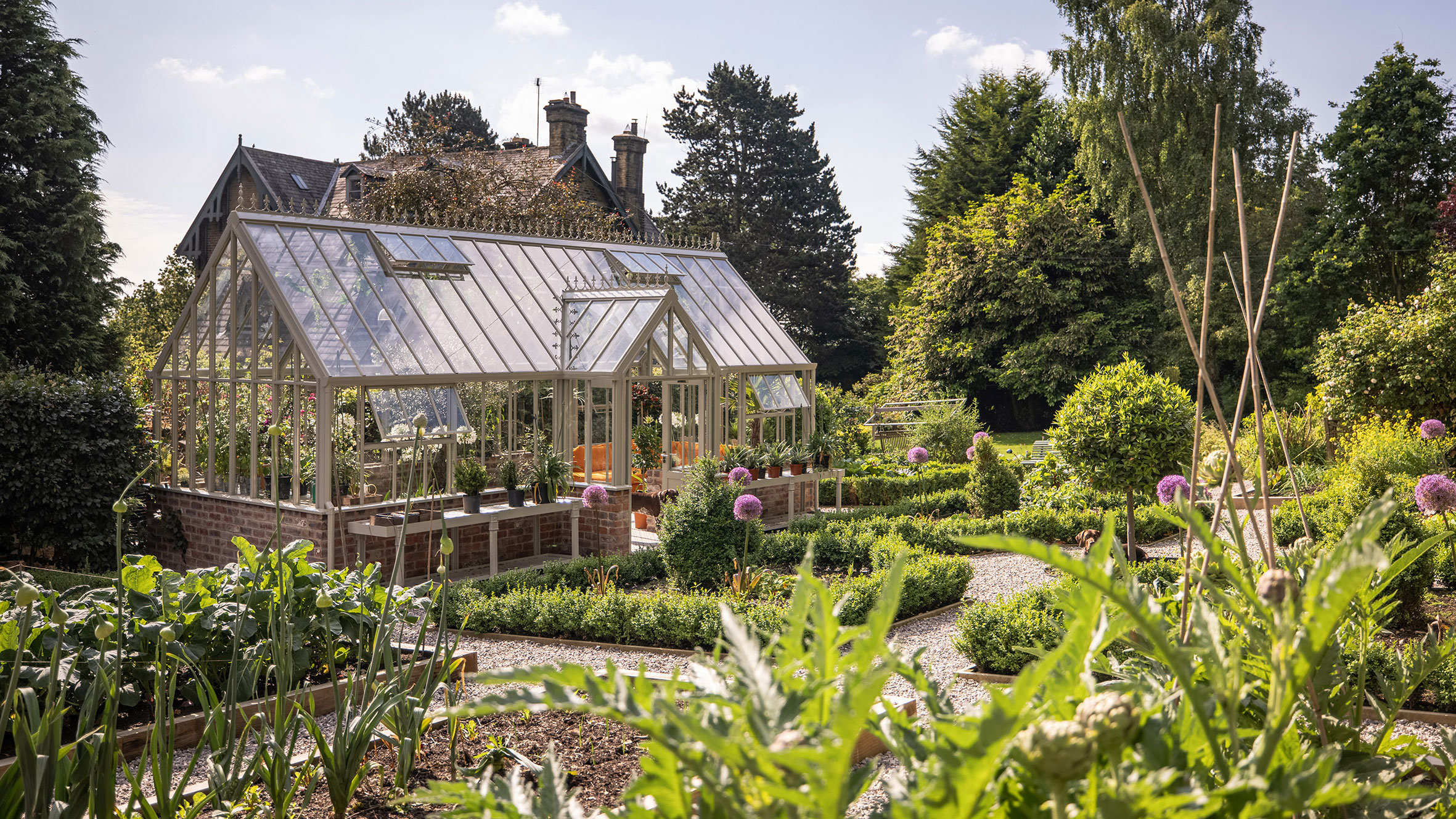
Every keen gardener will at some point consider greenhouse ideas as they can transform the way you garden. A greenhouse will allow you to raise young plants and sow seeds earlier in the year, keep tender plants going over winter, and grow exotic varieties that wouldn’t survive out of doors.
You won’t look back once you’ve invested in a greenhouse, but you need to get the design right from the start to ensure it lives up to expectations, both practically and aesthetically, and also complements your other garden ideas
For those with enough time and space, the opportunity to raise seedlings, grow indoor crops and overwinter tender plants will surely never go out of fashion.
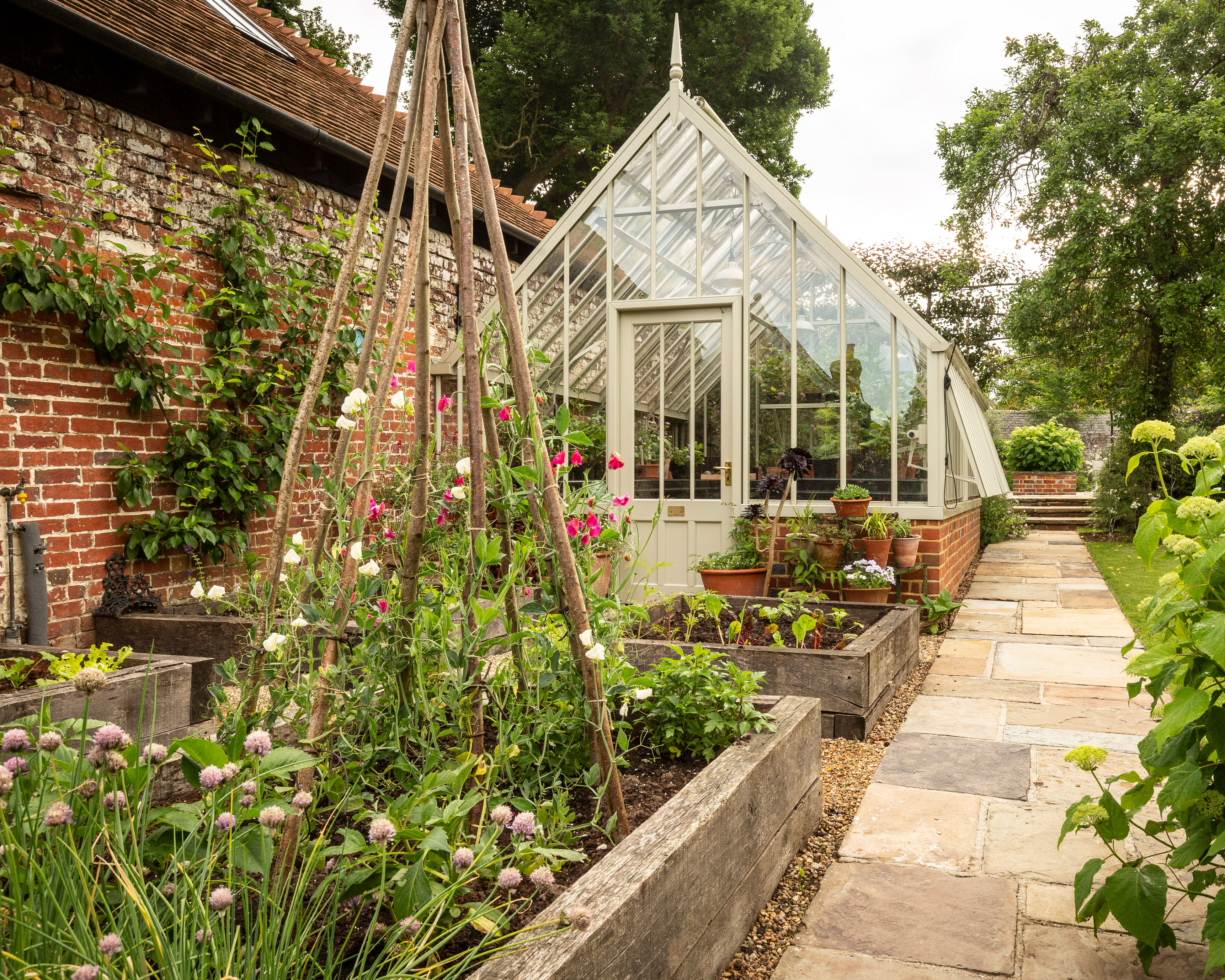
Greenhouse ideas
When you're searching for greenhouse ideas and inspiration, consider how much room you have available to accommodate the structure, whether it will be freestanding or will lean against a wall, and the style of greenhouse that would fit best with the rest of your garden. Ideally, you will also want to have a power source for heat and light – this is ideal when it comes to winterizing a greenhouse. And if budget is tight, there are plenty of DIY greenhouses ideas to consider trying too.
Follow our useful guide to ensure your glasshouse design is perfect for your requirements and is a valuable addition to your vegetable garden ideas.
1. Make your greenhouse a focal point
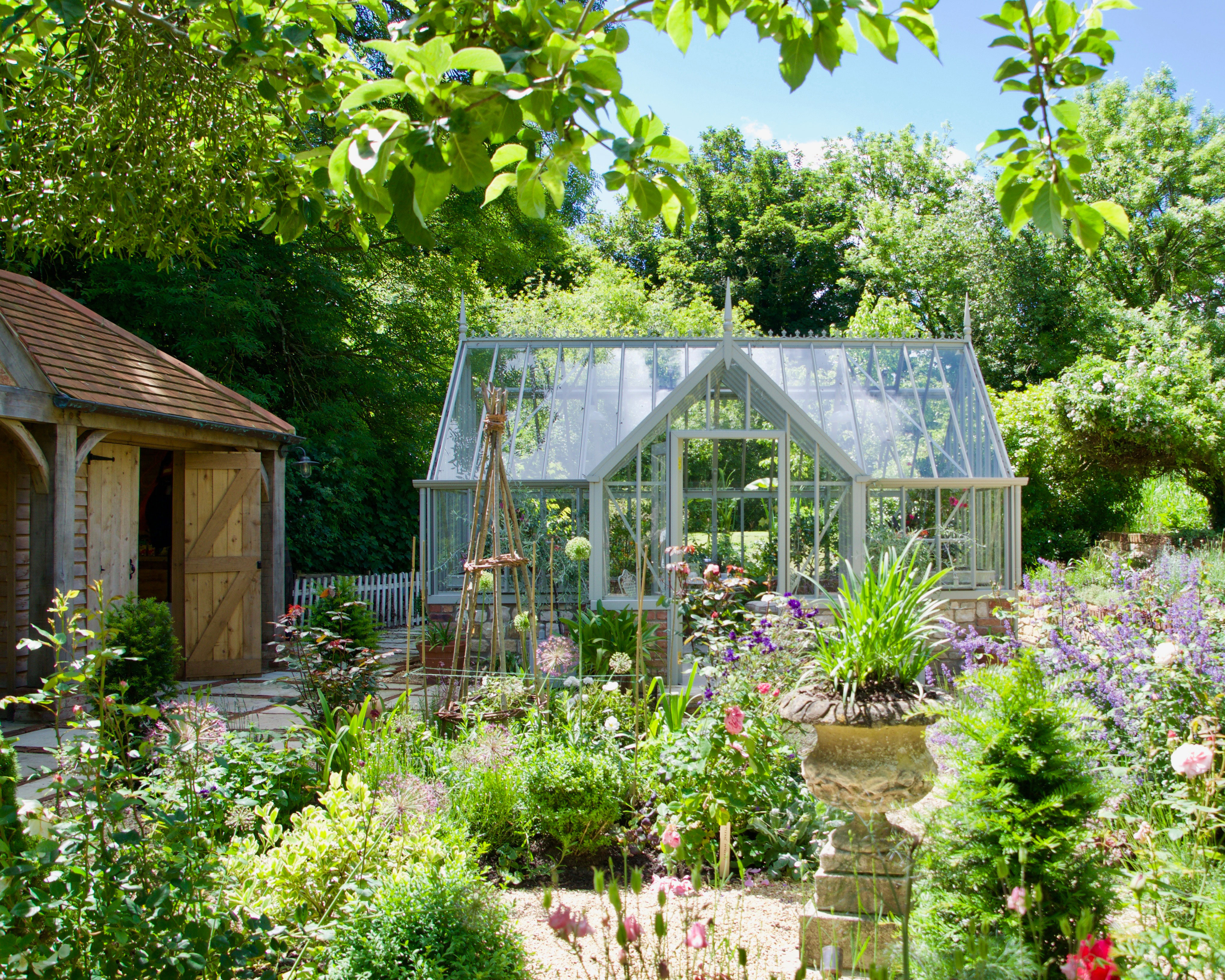
A beautiful greenhouse is not only useful but can also make a real statement in your garden. Choose a greenhouse design idea that works with the architecture of your home and its surroundings, but think carefully about where you are going to site it.
‘To be most successful, the glasshouse needs to warm up early in the morning and still be catching the last rays of sun,’ says award-winning garden designer Helen Elks-Smith.
‘Often, that is the same space in the garden where you might position somewhere to sit. Sometimes a compromise is needed and, if that’s the case, bear in mind that positioning a greenhouse where it will warm up quickly in the morning is better than missing the morning sun but catching it in the evening.’
2. Go big as you can with greenhouse ideas
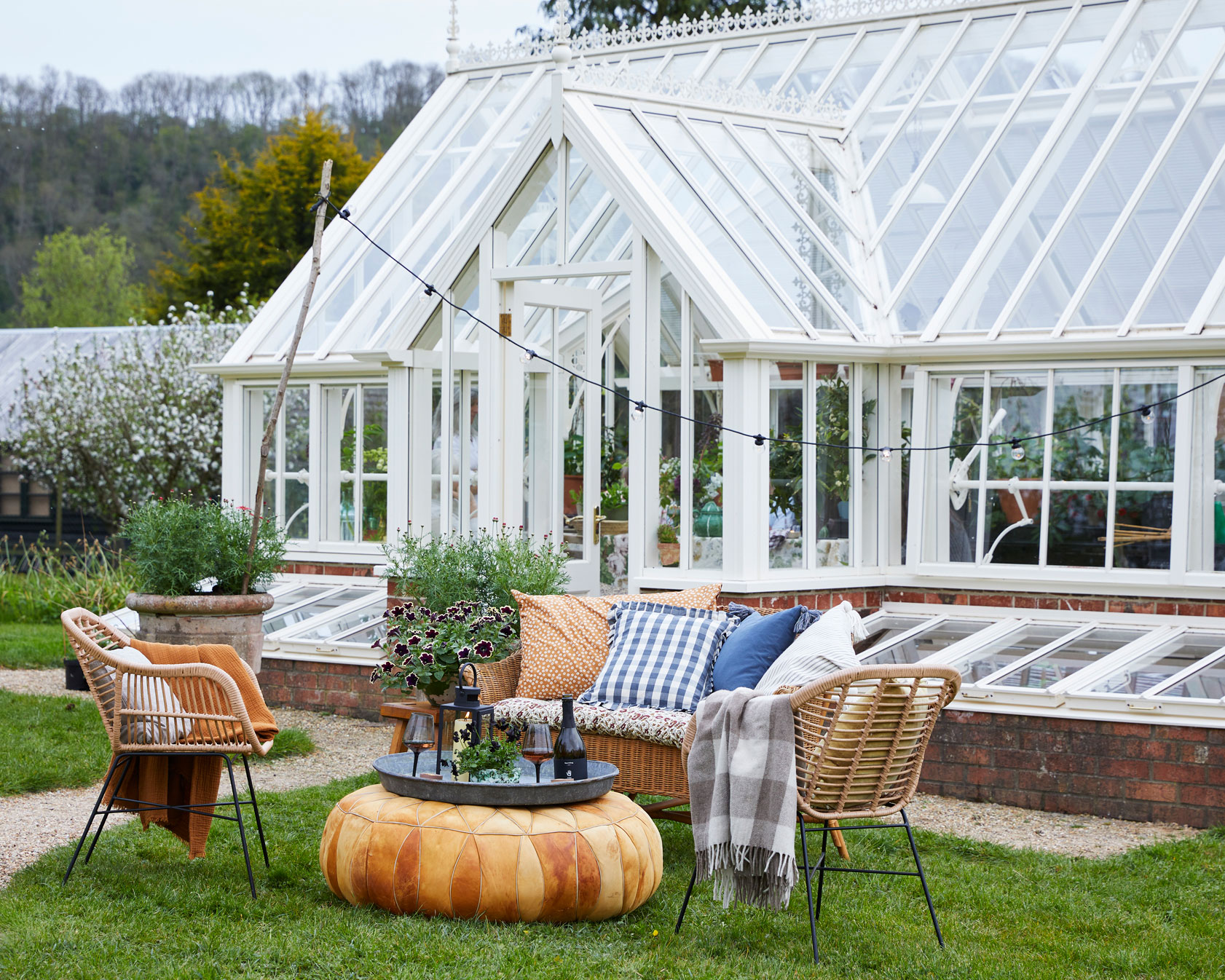
As soon as you start planning a greenhouse, you’ll almost certainly wish it was bigger, so go for the largest size you can.
In an ideal world, a greenhouse design should be at least 6ft wide to ensure there is plenty of room, not just for plants but for you to move around easily inside, too. When you’re planning your greenhouse design, you need to allow enough space around the perimeter of the base too – at least 1.5 metres – to allow access for cleaning or to water butts.
3. Optimize with an octagonal or hexagonal design

Even if you only have very limited outdoor space patio, a greenhouse idea can still be an option. ‘The staging, or shelving, in an octagonal greenhouse tends to go all around, so while there is less space, there is also less wasted space used up by a path,' say the experts at The Greenhouse People.
Octagonal greenhouses have the additional benefit of receiving sunlight from all angles throughout the day, too providing the ideal conditions when you're considering the best food to grow in a greenhouse.
Another way to ensure you're getting as much sunlight to your plants as possible stay on top of how to clean a greenhouse.
4. Aim to grow high
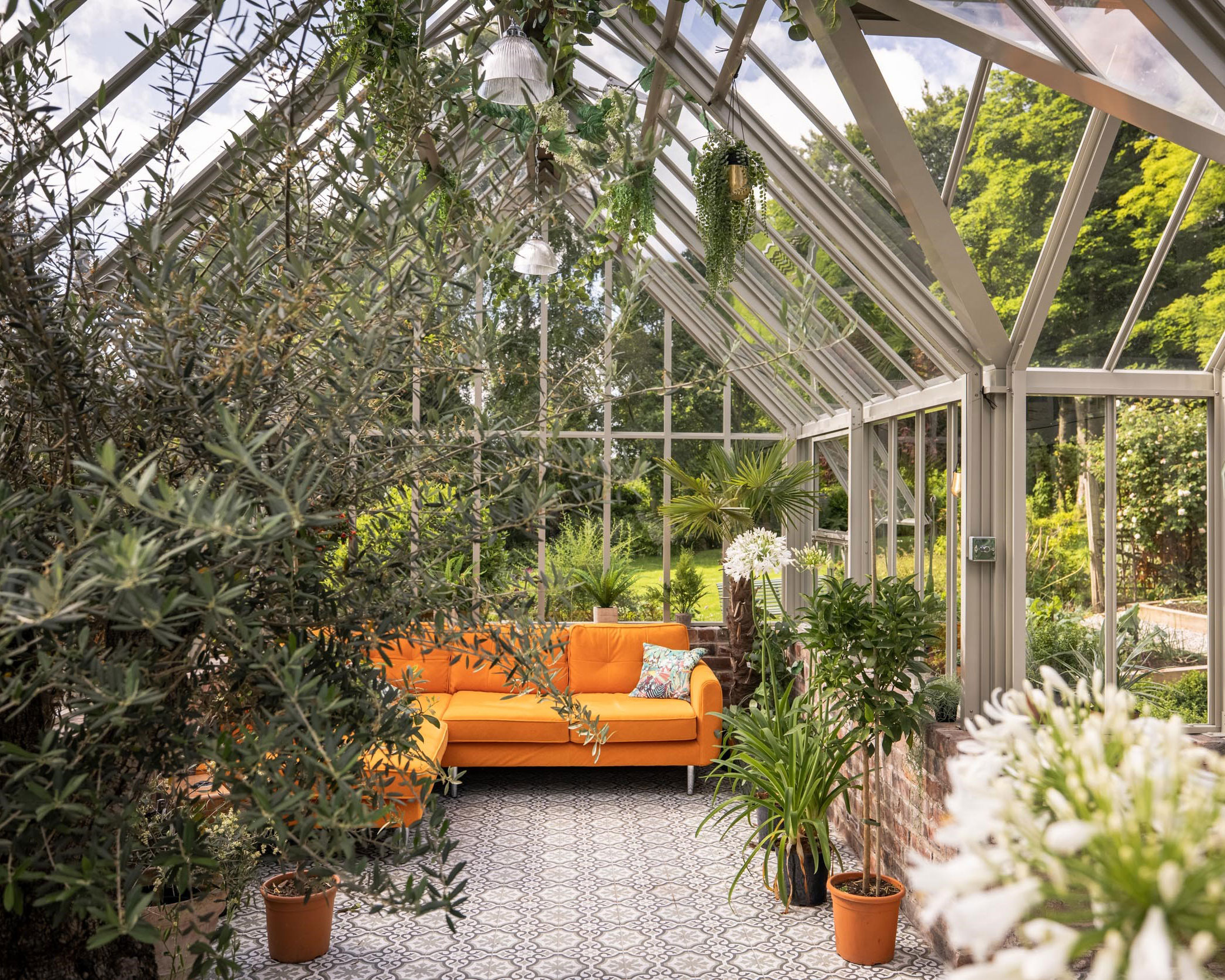
If you want to grow tall plants, like a mimosa tree, yuccas, palms or exotic ferns, for a tropical garden idea, for example, look out for greenhouse ideas with a higher than usual pitch.
This is also useful if you plan to grow climbing plants or train a fast growing flowering vine in your greenhouse.
A greenhouse with a high pitch and a modern architectural design is also a good choice if you plan to use it for sitting or dining, as well as give it the look of a stylish garden room.
5. Position a greenhouse close to the house
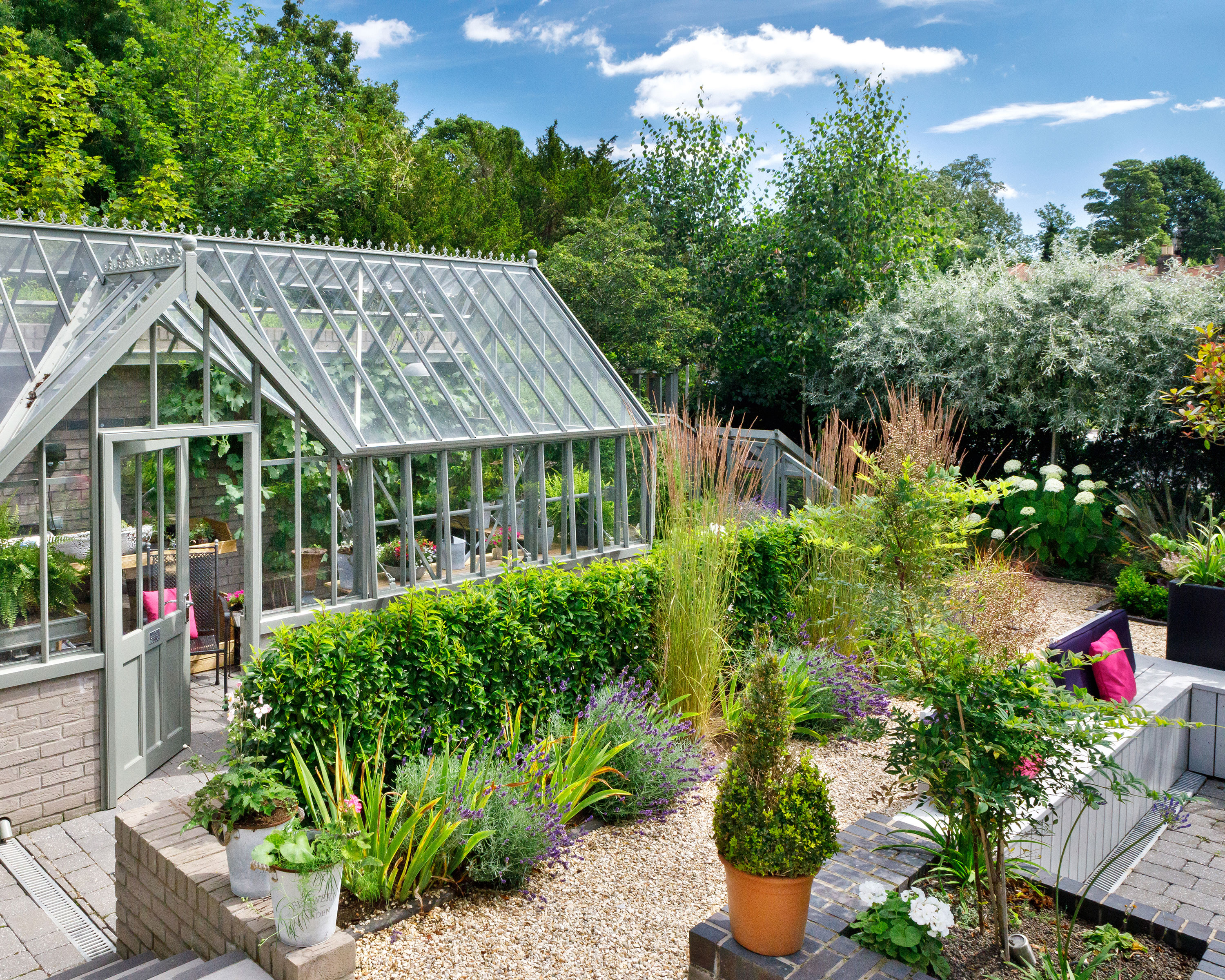
When you’re planning greenhouse design ideas, consider the overall design of your garden so that it fits in seamlessly.
‘Think about how far away the glasshouse will be from the house,’ advises Helen Elks-Smith. ‘Plants that grow under glass tend to be fairly demanding, often requiring attention twice a day, and any route to and from the house needs to be a pleasant walk so that the constant movement doesn’t simply feel like a chore or a burden but rather something to be enjoyed.’
Make sure the garden path to the greenhouse will be practical for use throughout the year.
6. Use it for dining and entertaining
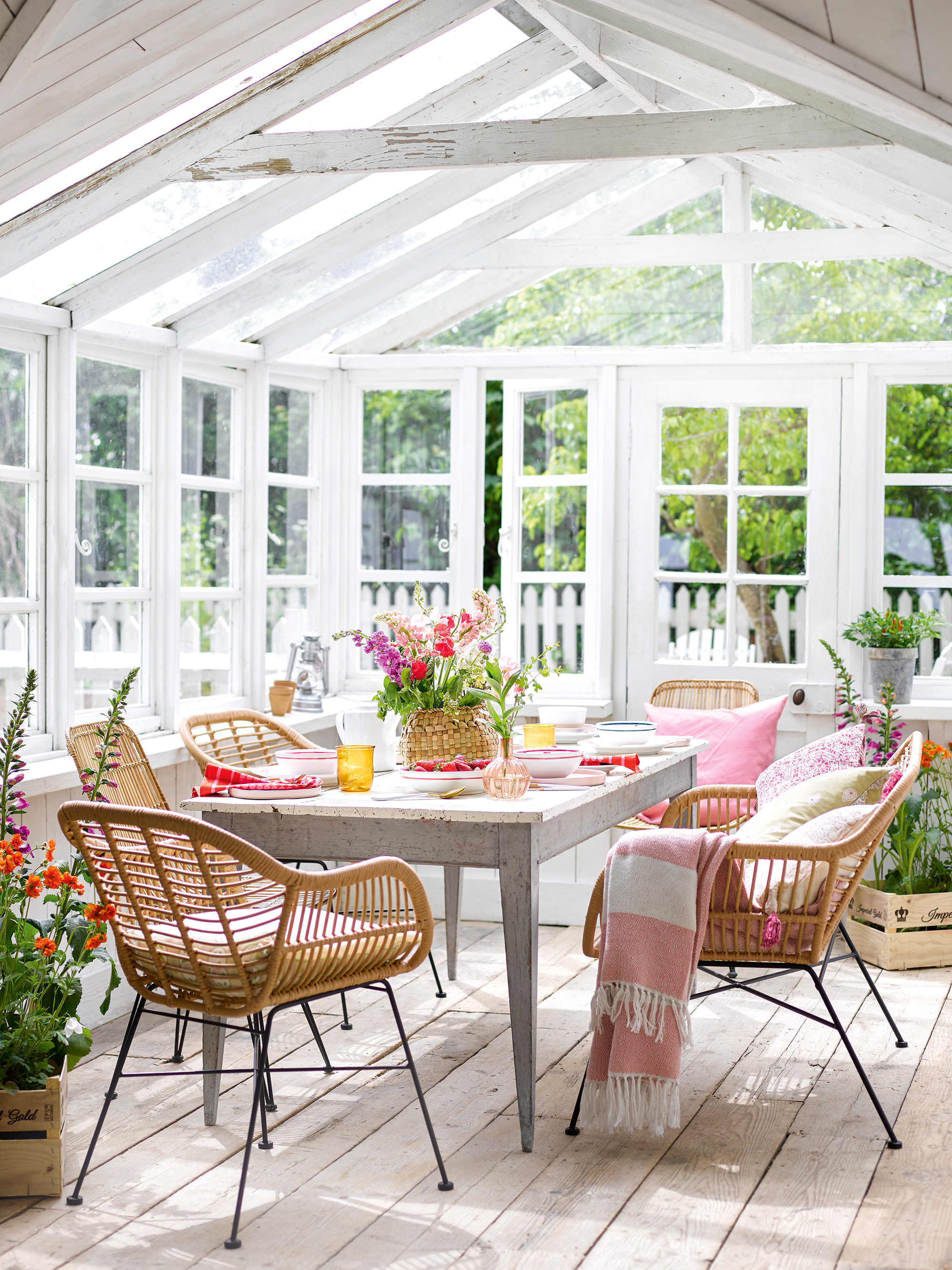
There’s a big trend these days for greenhouse ideas that are more than just for raising plants. Many designs are so stylish that they’re more akin to conservatory ideas, and they make ideal dining and sitting rooms, especially in fall and winter.
‘There is definitely a sense that the appreciation homeowners have for design inside their homes is now moving into their gardens, too. Their greenhouses may have a functional purpose, but they have a very clear design aesthetic with contemporary and architectural styles more popular than ever, with people introducing relaxation, dining and lifestyle elements into their greenhouses,’ says Hartley Botanic CEO Tom Barry.
Lisa Morton, director at Vale Garden Houses, agrees that a greenhouse design can be a beautiful space for people as well as plants. ‘Painting a glasshouse in muted tones and choosing rustic furniture makes for a calm and relaxing room,’ she says.
7. Build a wall at the base
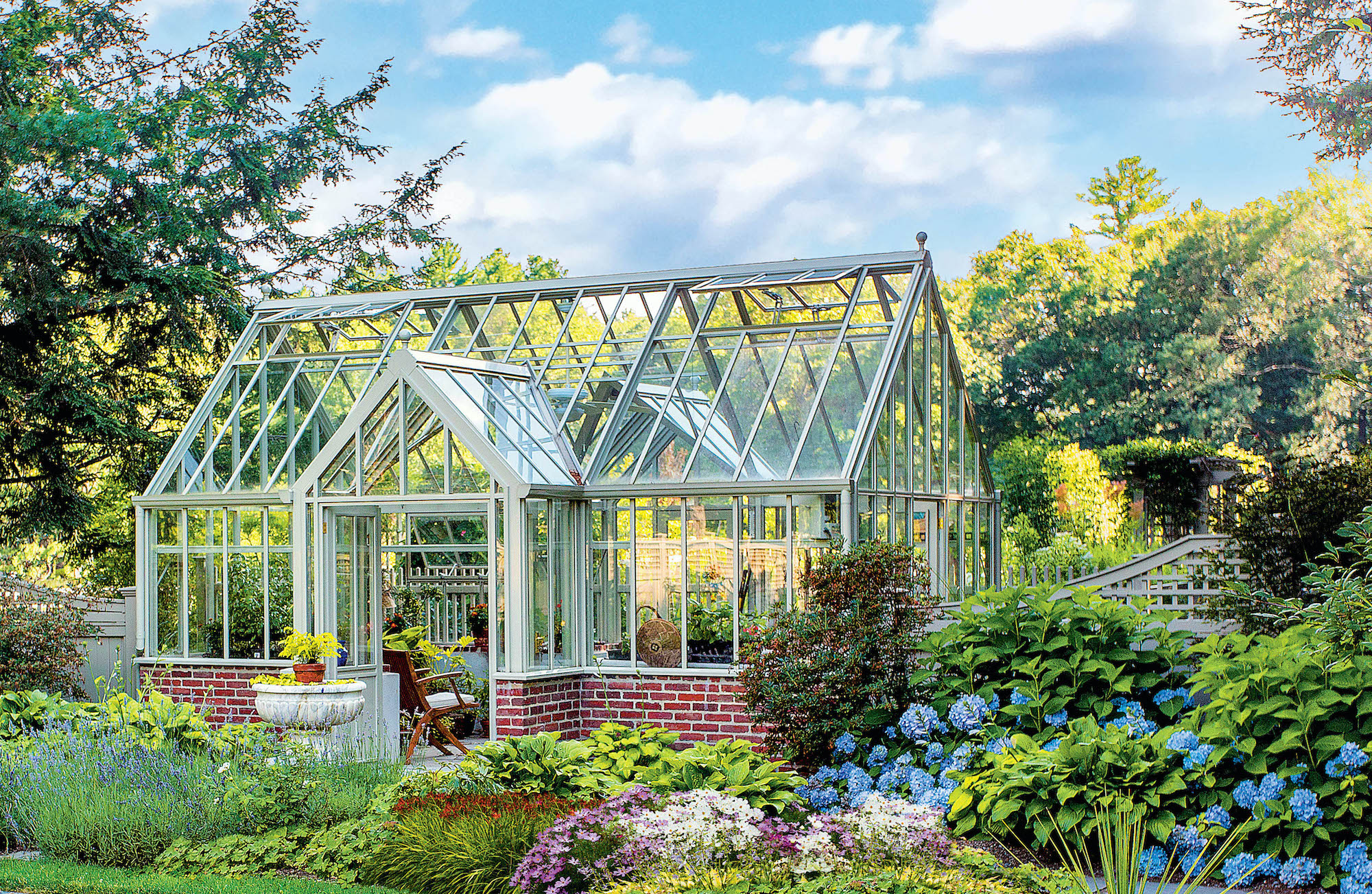
A greenhouse design ideas with a dwarf wall has several advantages over all-glass structures. The wall protects against low-level breakages from misfired footballs or errant stones sent into orbit by your mower, and hides any unsightly gardening paraphernalia like grow bags and weedkiller.
‘Dwarf walls also provide the opportunity to be creative in your use of materials and produce a very aesthetically pleasing result,’ says Christopher White of Hartley Botanic.
A dwarf wall built in similar brickwork to your home can help it settle harmoniously into place.
8. Increase your options
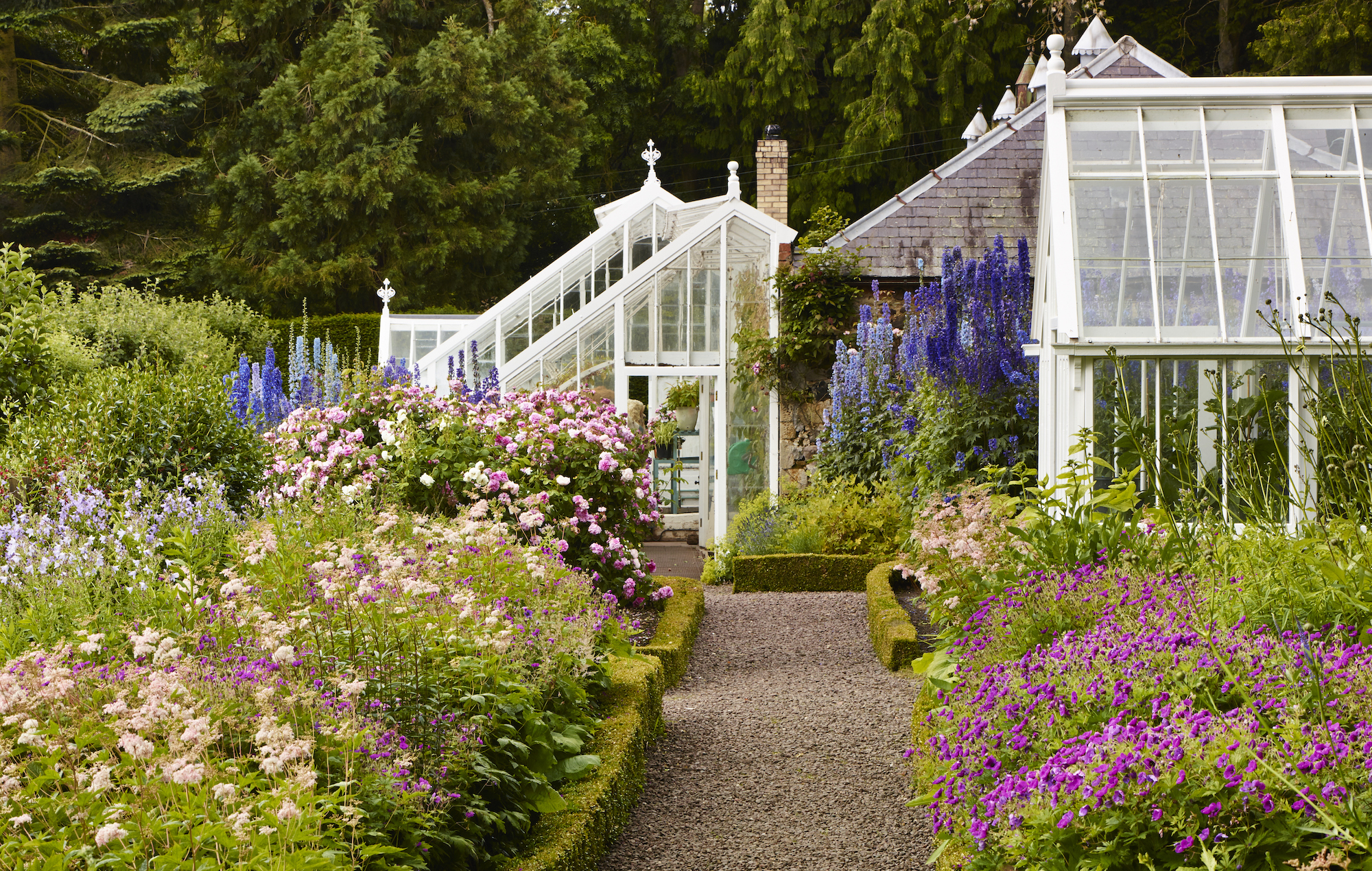
Keen gardeners with room to grow – literally – can opt for multiple greenhouses to create optimum growing conditions for different plants.
Different heating options, from cold frames and temperate to steamy and tropical, will broaden your horticultural horizons, creating unique microclimates in your own backyard.
9. Incorporate it into a kitchen garden
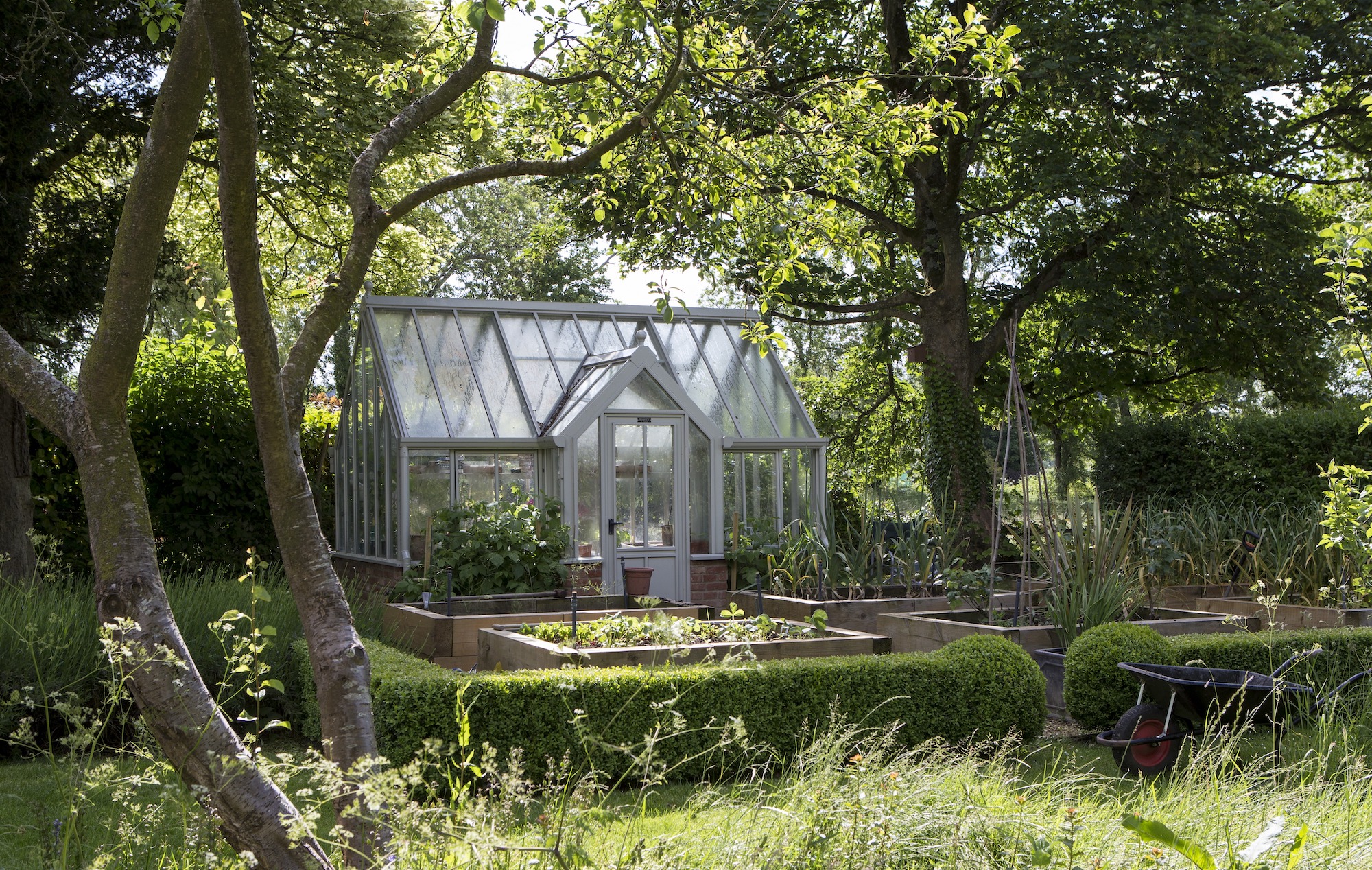
Position your greenhouse at the heart of your kitchen garden ideas and increase the amount and variety of crops that you can grow.
If you are growing tomatoes, more tender herbs such as basil, winter salads, eggplants, chilies, zucchinis and similar warmth loving vegetable or fruit crops, they will all thrive under glass. Tougher crops can be started off under glass and then transplanted to beds outside as part of your vegetable planting calendar.
10. Paint your greenhouse
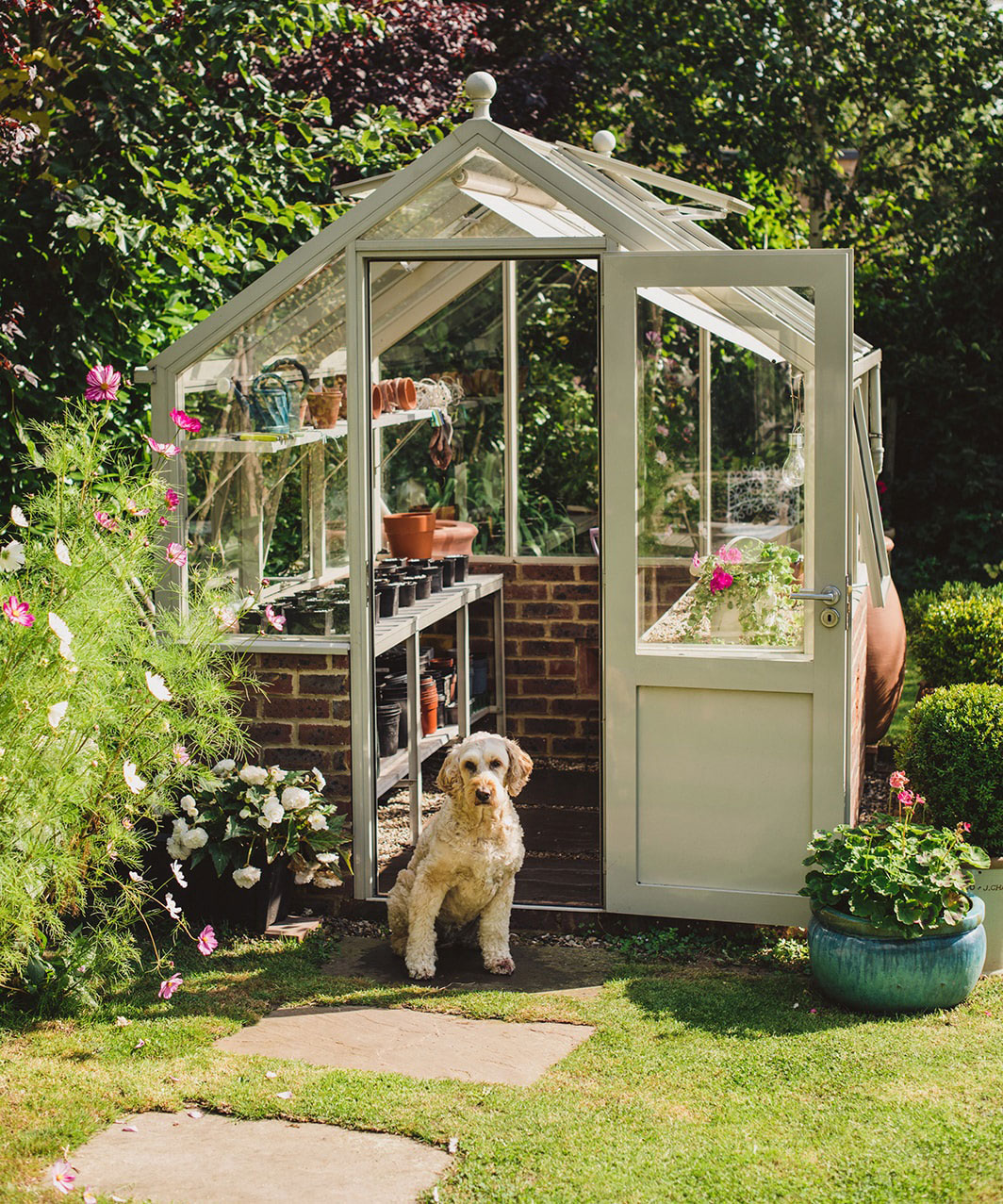
Just as with interior design, greenhouse design stands or falls on the finishing touches. An unpainted aluminium greenhouse can look a little utilitarian, for example – but paint it in a stylish color and it is transformed into a beautiful focal point.
If you love the graphic lines of Crittall glazing, black-framed greenhouse ideas could be for you. Get the look for less with a design made from black aluminum or black-painted timber.
‘If you’re going for a strong color, opt for a greenhouse with a less elaborate design,’ says Graeme Runeckles of White Cottage Greenhouses.
11. Add a shed to your greenhouse
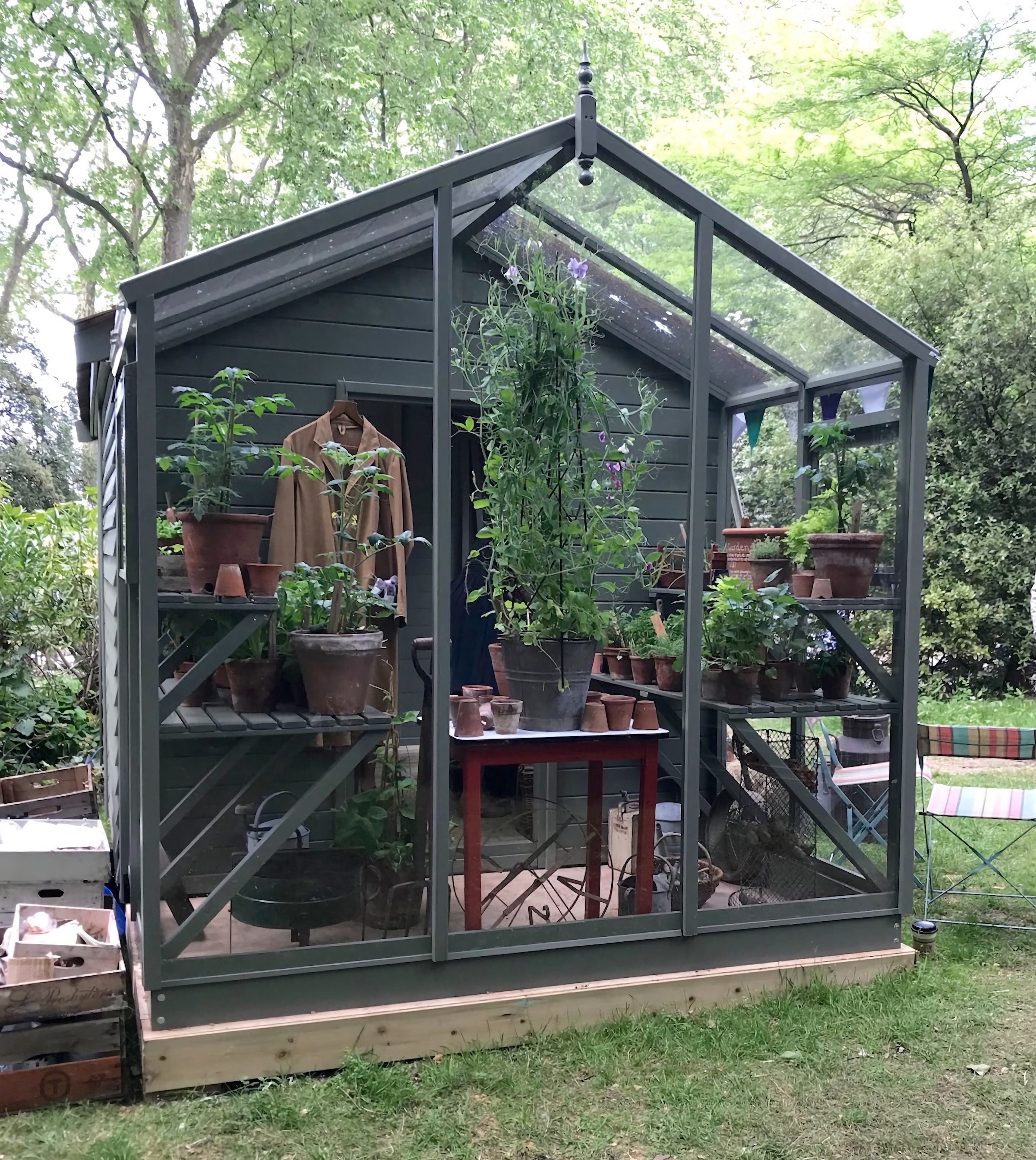
One part shed, one part greenhouse – grow-and-store garden buildings, that fuse greenhouse and shed ideas are highly practical.
This design has a glazed front half, which provides an attractive space to showcase your plants, while your gardening clutter and potting compost can be kept neatly out of sight as part of the shed storage ideas behind.
12. Pick a pitched roof
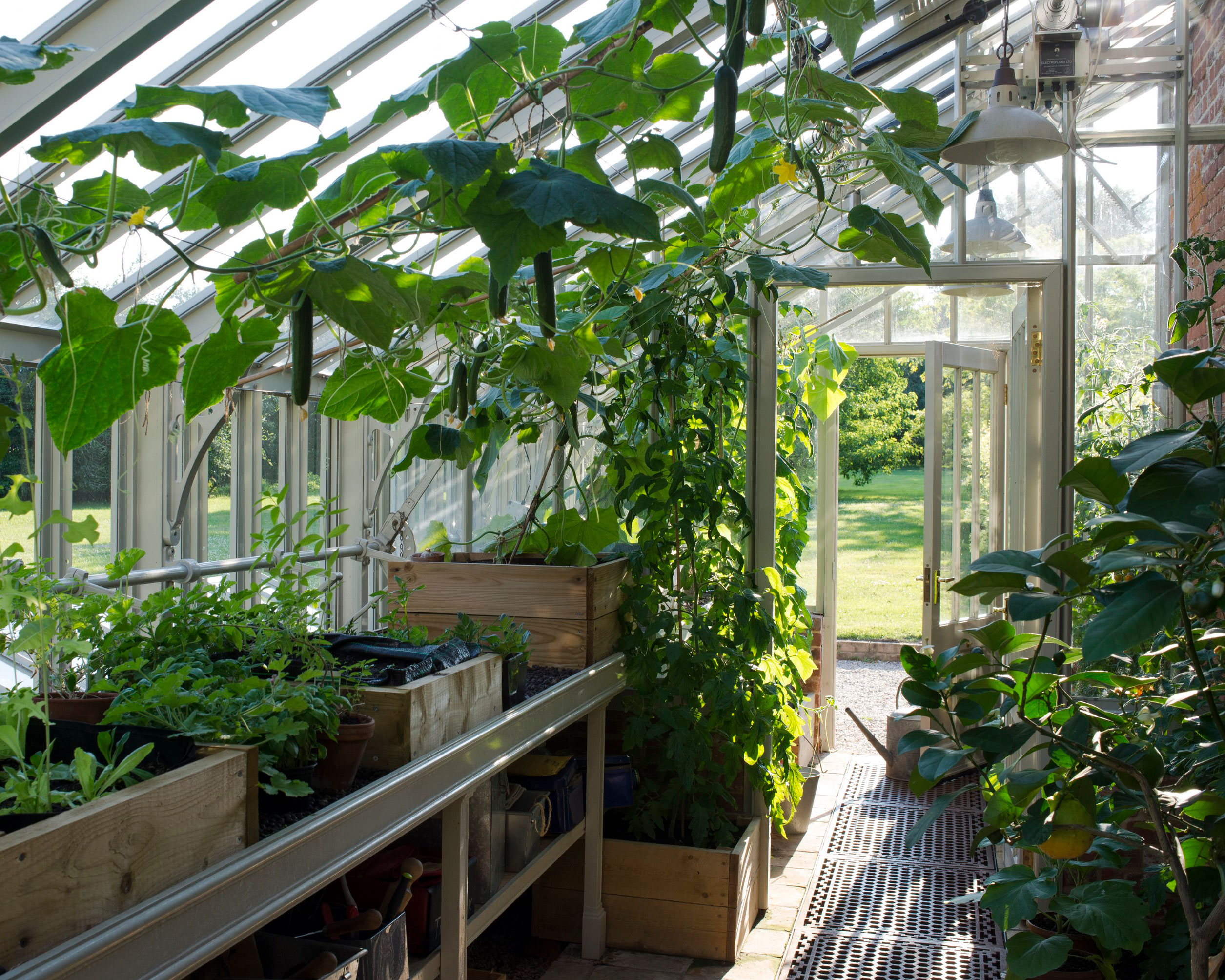
‘The extra height, created by a traditional Victorian 45-degree pitch roof, gives more room for specimen plants and tall crops, such as growing cucumbers vertically and tomatoes,’ says Matt Jordan of GBC Group.
‘It also provides better airflow and temperature regulation, which is important during the summer months when plants can be scorched.’
In high summer, a greenhouse can get very hot so good ventilation is essential. In even the smallest models, look for side vents and an opening rooflight, or window, at the top.
13. Bridge the gap
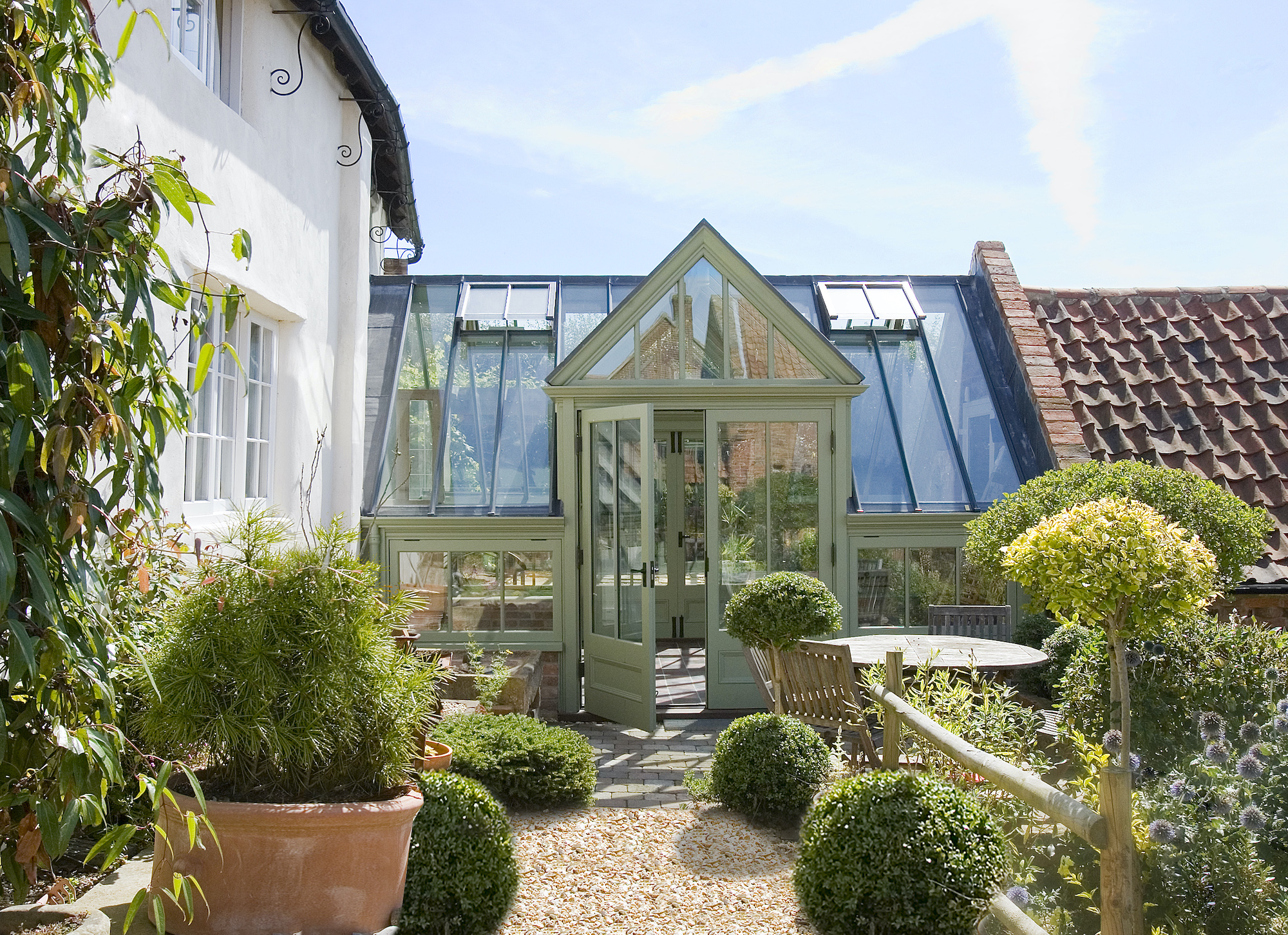
A glazed structure, such as a greenhouse idea, can provide a charming link between two buildings with different types of construction. It will also create a green oasis in the centre of your home.
'Here, the steep pitch roof, low eaves and feature doors help bridge the change in levels between the house and outbuildings,' explains Lisa Morton of Vale Garden Houses.
14. Keep greenhouse ideas small
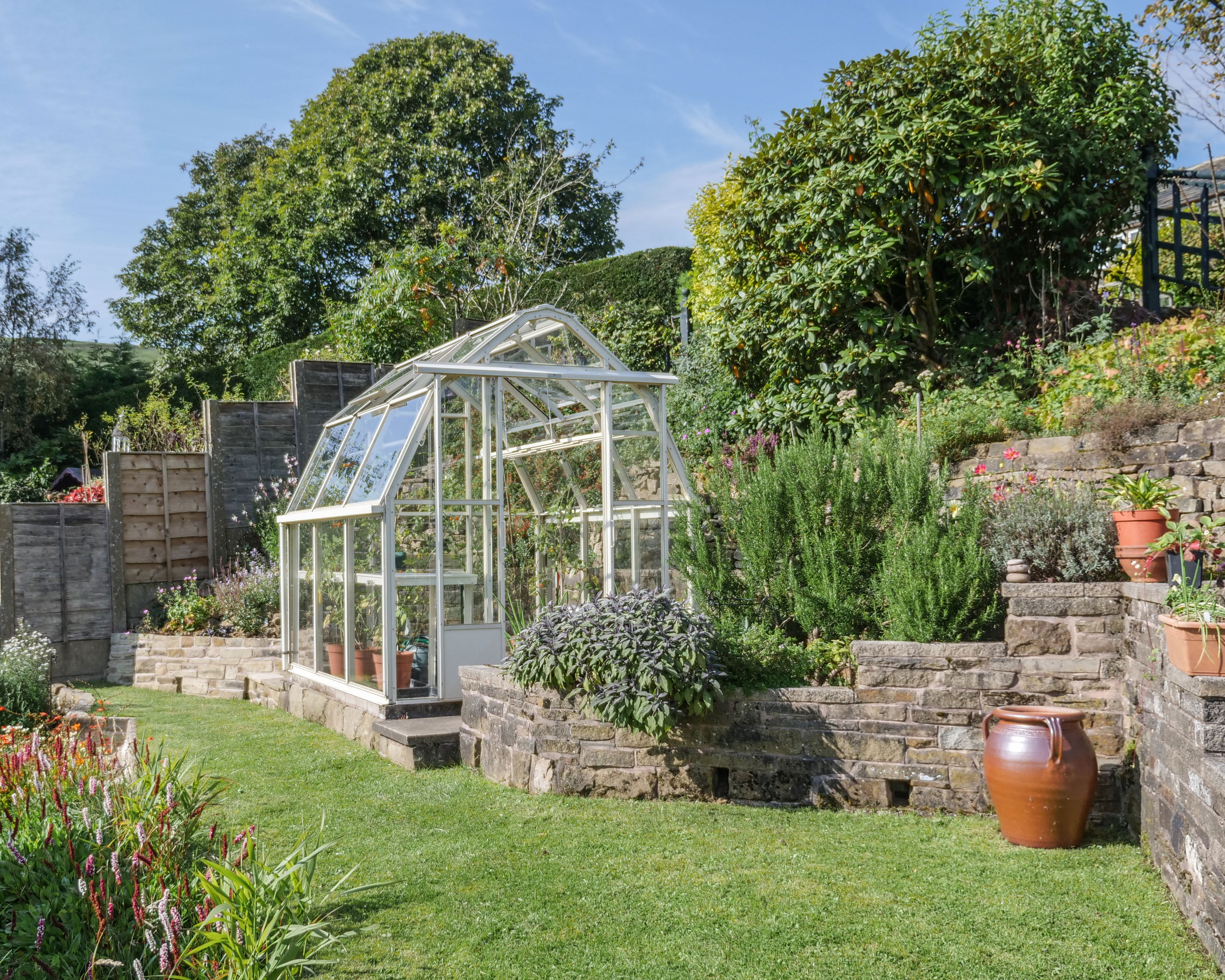
‘Just because you have a big garden, doesn’t mean you need a big greenhouse. Evaluate how many plants you plan to cultivate in your greenhouse and pick a size to suit,’ advises Andy Baxter, managing director of Internet Gardener.
The best thing about a small greenhouse is that it will fit in just about any space. So it’s easier to find a south-facing spot or find room to fit a greenhouse into small garden ideas.
In a tight spot, the shape of your greenhouse can make a big difference and a design with large expanses of glazing is always a good option. Try to avoid extra internal struts, cross-beams and columns. This is good for those with smaller gardens and maximizes the available growing space inside.
'Tall, narrow greenhouses are better at holding light than shorter ones. Small greenhouses can get very hot, very quickly, so it’s important to have adequate ventilation and keep everything fed and watered,’ adds Andy.
A tall and narrow greenhouse design idea can also work well in a sloped backyard.
15. Go Victorian with a vinehouse
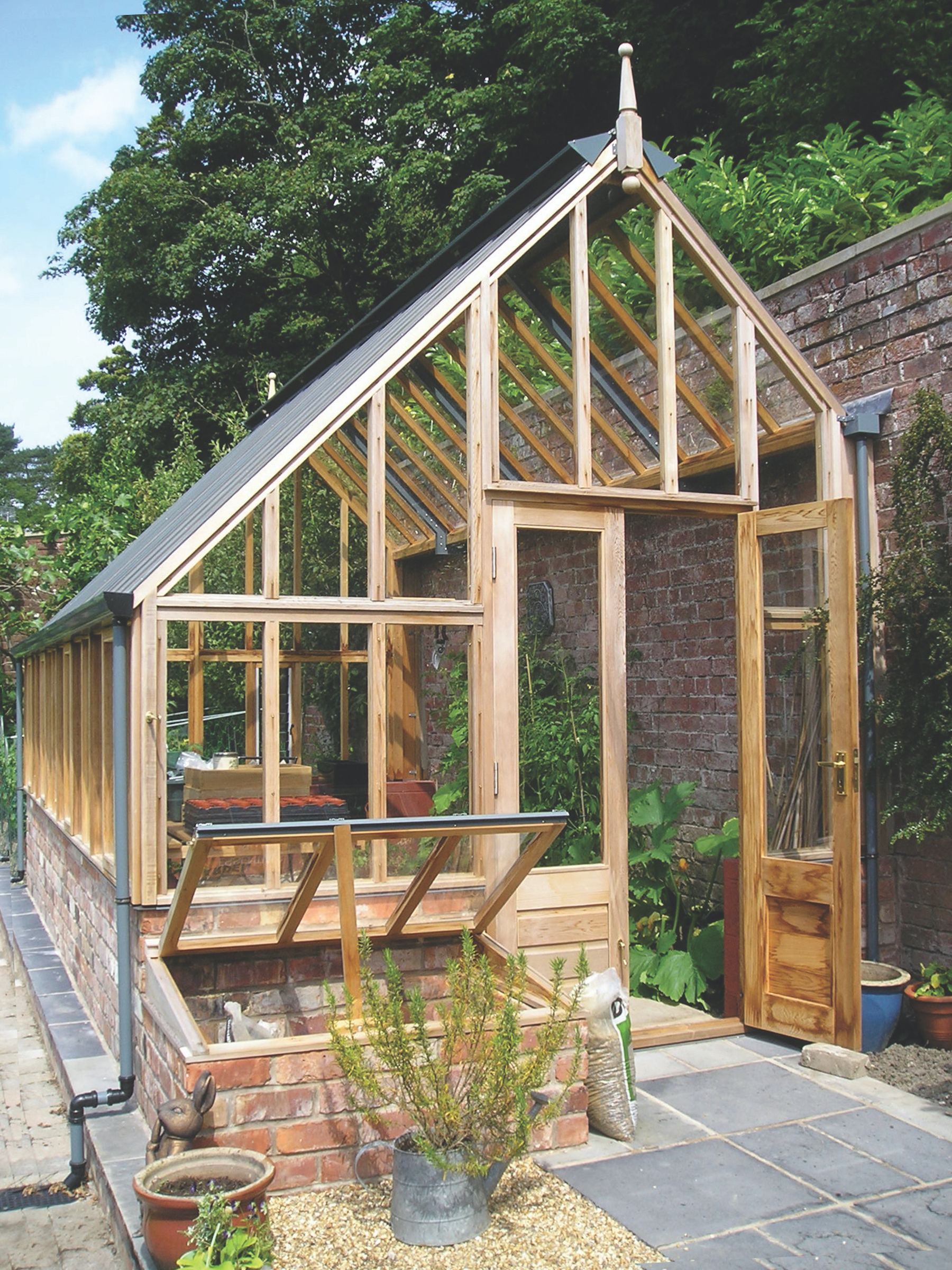
'The Victorians were the first to design vinehouse-style greenhouses, which utilise existing house or garden walls,' says Catherine Kirkland, marketing manager at Gabriel Ash.
One advantage of a vinehouse over a lean-to greenhouse is that the roof pitch is offset, so it doesn't require such a high wall to achieve a structure of decent height and width.
'The wall acts like a giant storage heater, absorbing warmth from the sun in the day and slowly releasing it during the night,' says Kirkland.
16. Choose clear glazing
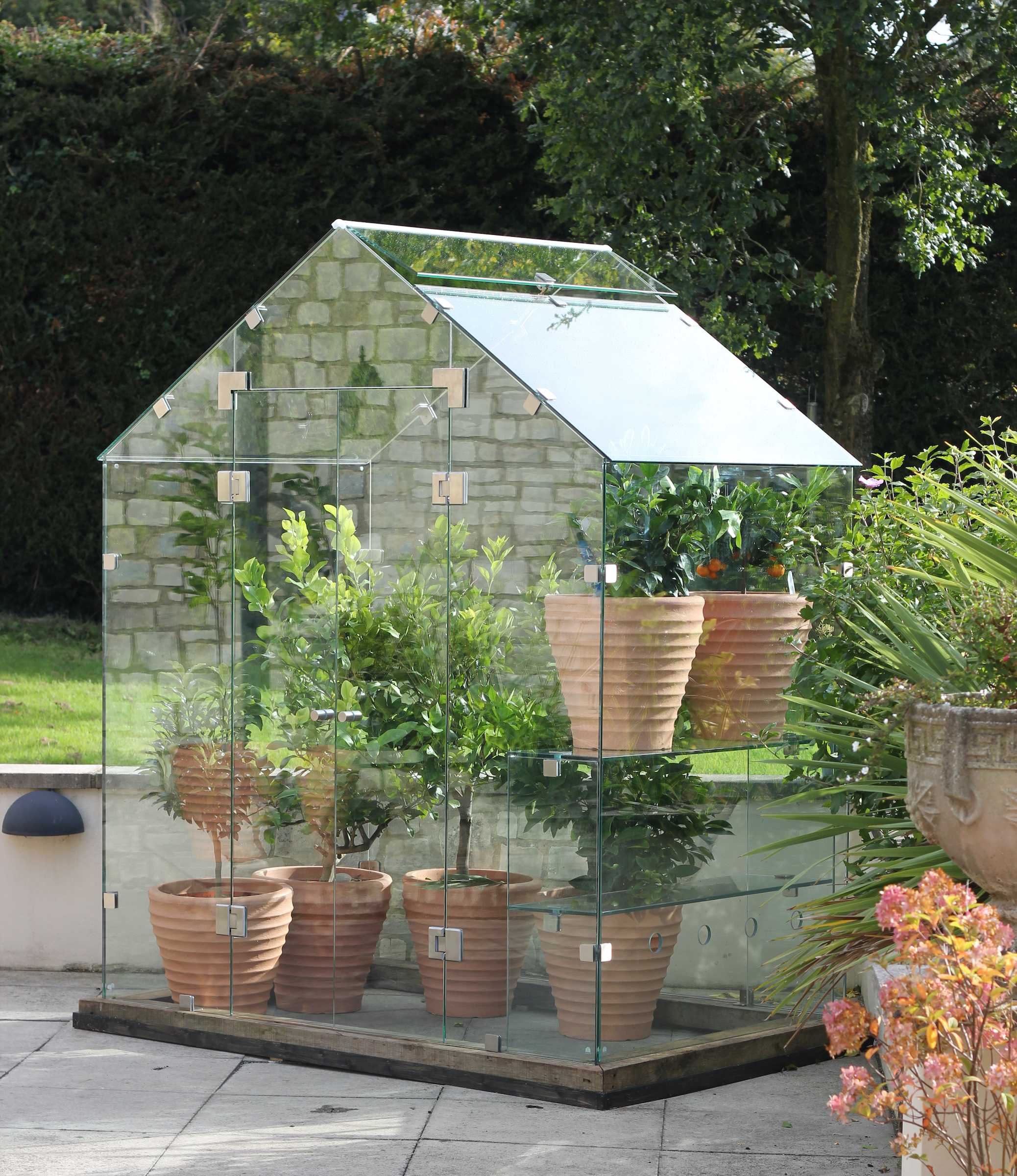
Virtually invisible, a frameless glass structure, like this bespoke model from Pure Greenhouse, allows clear views of your garden’s flowers and produce, both inside and out.
Made from 10mm-thick toughened glass joined by slimline stainless-steel brackets, this design features an innovative full-ridge glass-to-glass ventilation system that promises commercial-level air control.
Even the shelving is frameless, allowing maximum light to reach plants on the lower levels, a perfect small vegetable garden idea for optimizing your growing space.
17. Get the natural look with wood
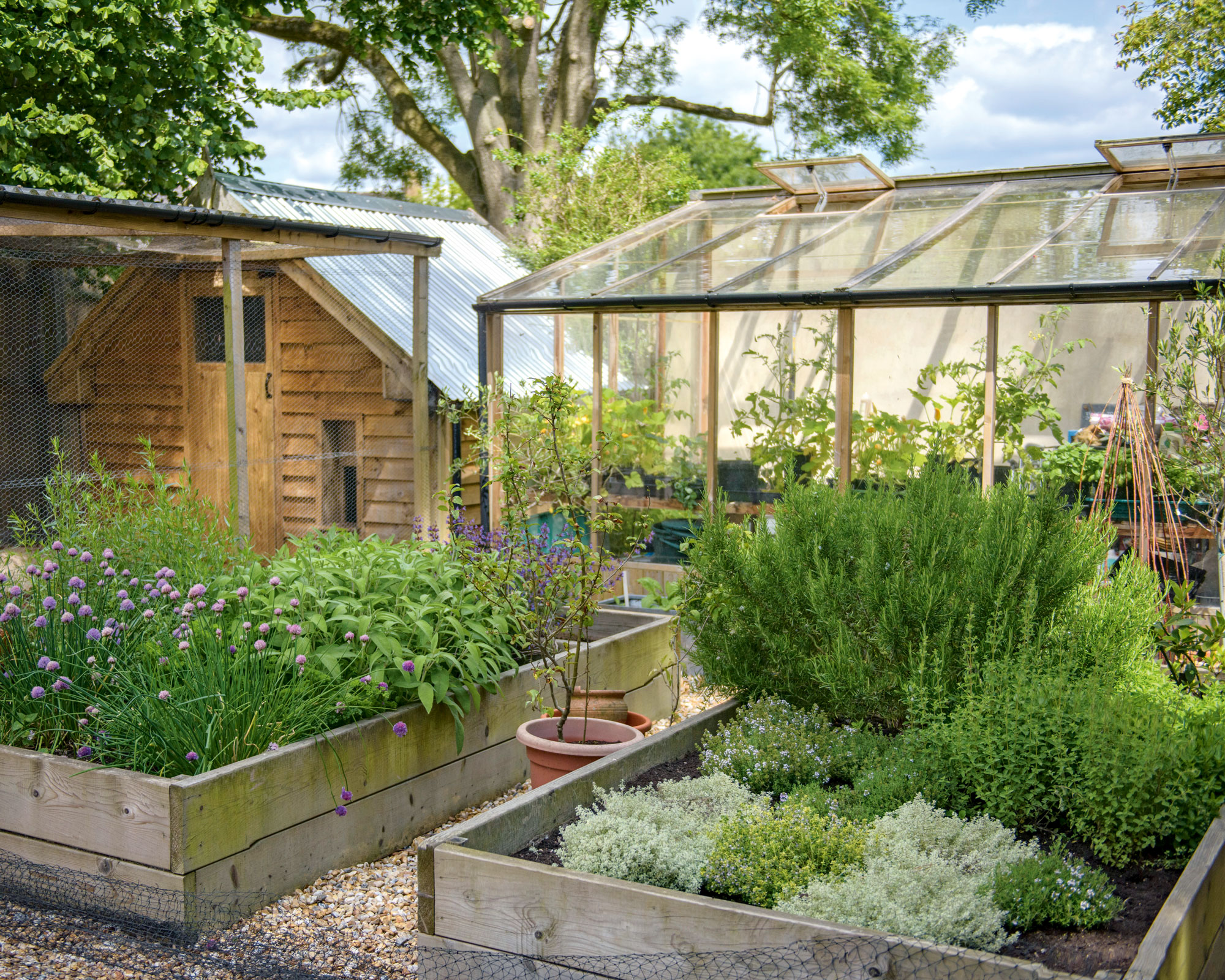
The latest innovations mean classic wooden greenhouse ideas aren't as maintenance heavy as they once were.
'Canadian western red cedar is very high in natural preservative oils, making it virtually immune from decay and a great choice for greenhouses,' says Richard Baggaley, director at The Greenhouse People.
Cedar also has a unique subtle aroma that can deter pests – handy when planning the best food to grow in a greenhouse.
However, although traditional timber structures are undeniably beautiful, there are some that will still require quite a lot of maintenance. ‘They need to be repainted every year or two and reglazed every five years, which is time-consuming and costly,’ says Andy Hancock, managing director at Alitex. ‘They can also be susceptible to warping, shrinking, expanding and, of course, rotting.’
18. Opt for lightweight aluminium
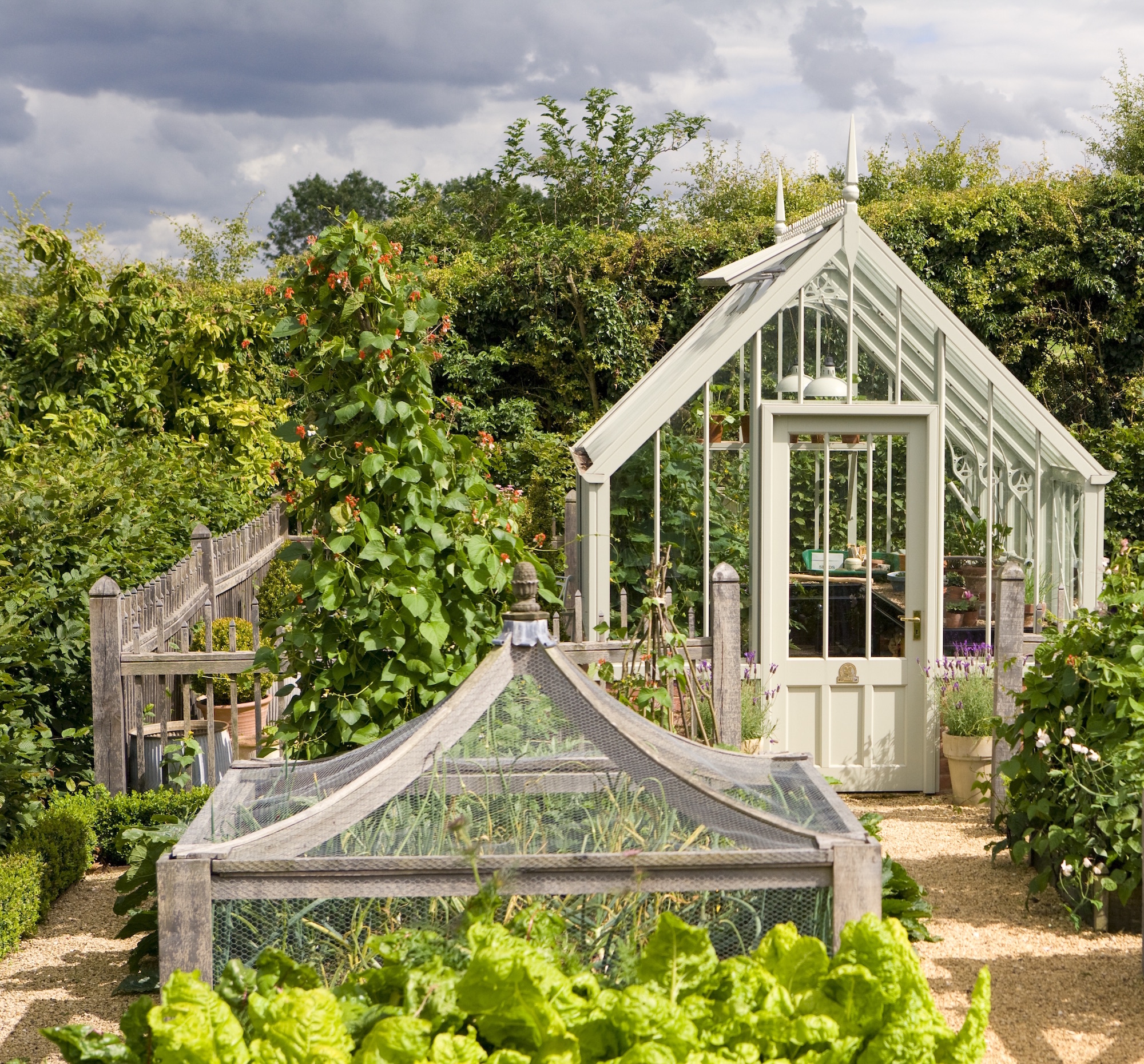
An aluminium greenhouse is designed to replicate the good looks of a timber structure. ‘Aluminium greenhouses simply need an occasional wash with soapy water,’ says Andy Hancox of Alitex.
Aluminium framed greenhouse ideas are loved for their lightweight composition, making construction quick and easy.
'Aluminium also enables thin but strong frames and glazing bars, allowing more light to flood the space,' adds Andy.
‘For extra strength and longevity, aluminium can be finished in a polyester powder coat. This extra layer is highly resistant to scratching, cracking, peeling, UV rays and rust. Maintenance is minimal – an annual clean is all that’s required.’
19. Lean in to a wall
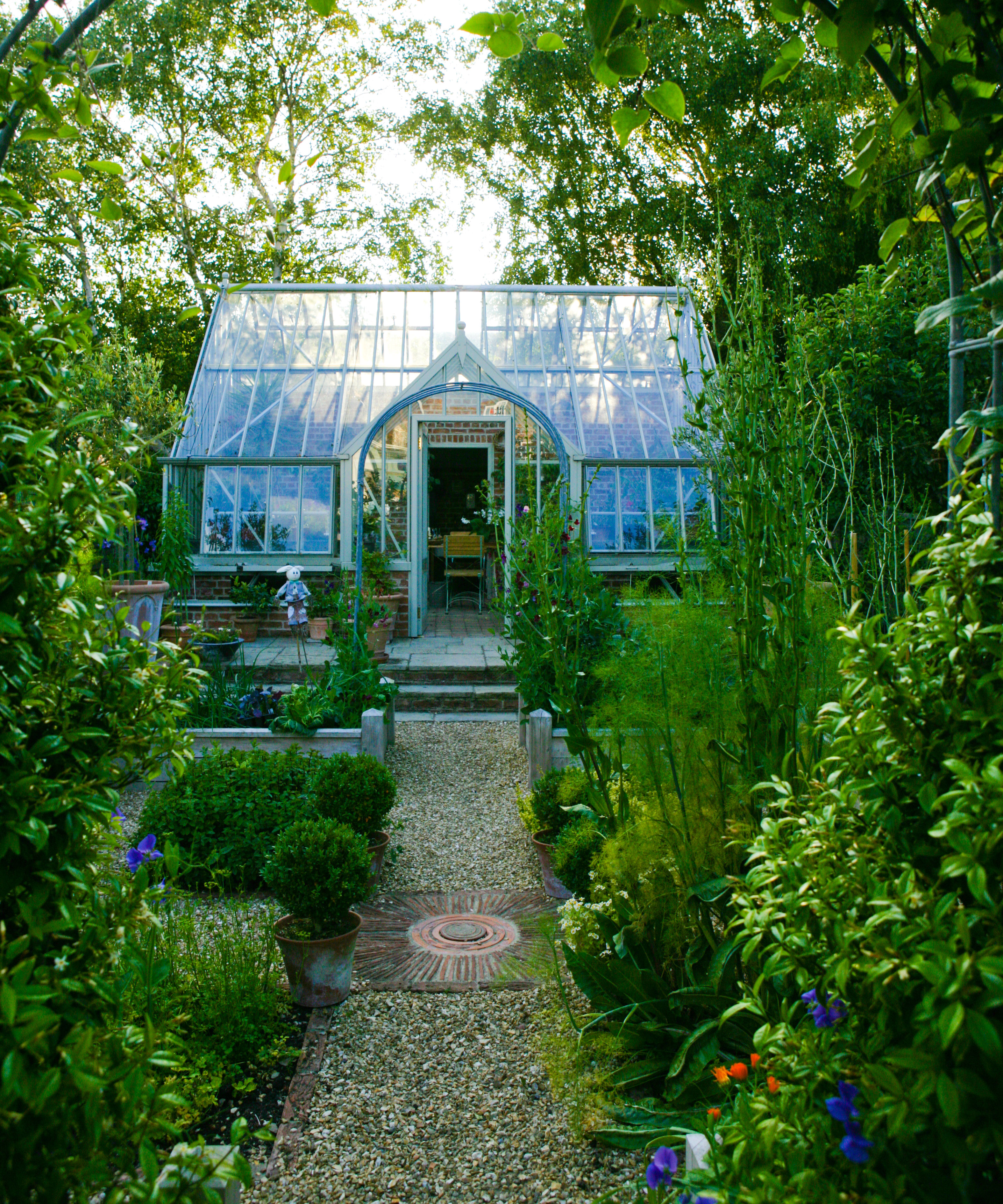
Lean-to greenhouses are perfect if you have a brick wall to attach them to – as well as being space-saving, the plants inside will benefit from retained and reflected heat, and this is especially true if it’s a house wall.
The wall can also play a key part of the greenhouse design as you use it to train fruit trees, vines, vegetable garden trellis ideas and ornamentals. To tie the greenhouse design in beautifully, consider building its dwarf wall in bricks that echo the brick of the adjoining wall.
Even the smallest of gardens or patio ideas usually has enough space to incorporate a lean-to style glasshouse, positioned against the wall of the property.
‘The close proximity to your house means it’s much easier to run electricity and water into the greenhouse,’ adds Tom Hall, owner of Alitex.
‘A power source means you can include outdoor lighting ideas to extend the hours you can garden during the winter, and will also allow you to consider growing exotic fruits.’
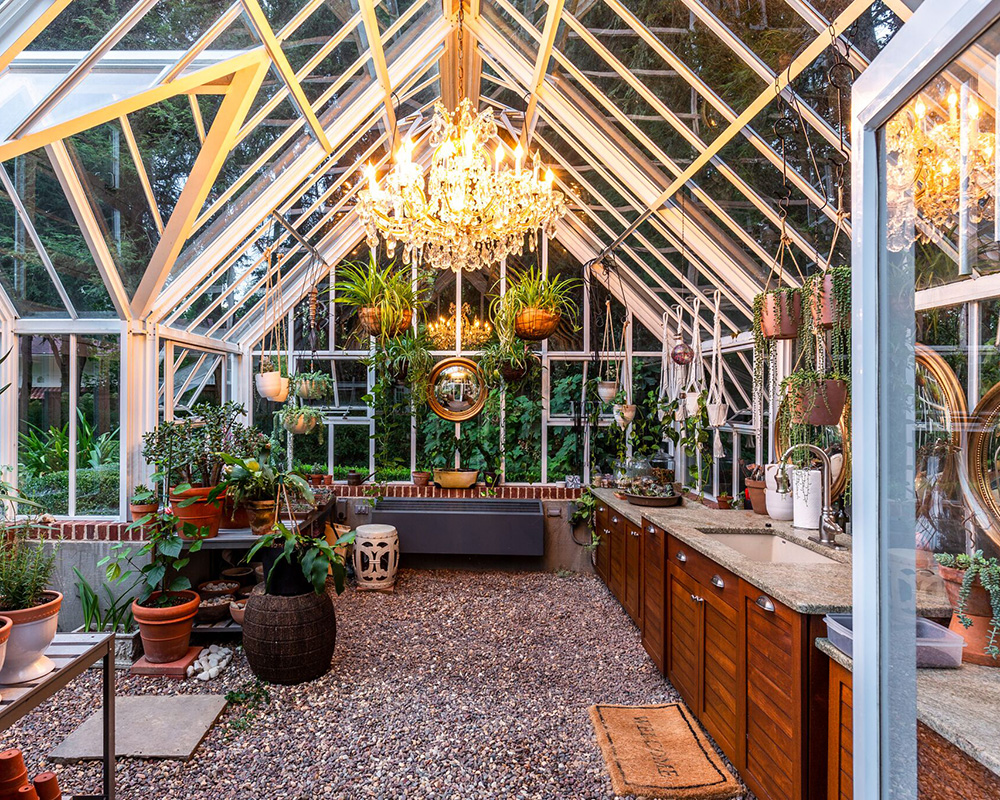
What is the most efficient greenhouse design?
Any greenhouse that is positioned in a sunny spot with plenty of light will be efficient, especially if it is south-facing and aligned from east to west to give maximum exposure to sunlight in the winter months. But an octagonal greenhouse arguably has the edge as it gets sunlight from all angles throughout the day.
Alternatively, a design with large expanses of glazing is always a good option.
Should I buy a greenhouse?
'The decision about whether to buy a greenhouse very much depends on your garden and gardening ambitions,' says horticulturalist Rebecca Bevan, author of The National Trust School of Gardening.
'If you need only to raise a few seedlings or overwinter a couple of tender plants, a sunny windowsill or cold frame may be sufficient. If you wish to raise a wide range of vegetables and flowers from seed, grow exotics or have a reliable crop of tomatoes, a greenhouse is a must.'
Where should I position my greenhouse?
'The most important consideration when deciding where to position a greenhouse is to try to find somewhere that has little or no shade cast on it from trees, buildings or hills,' says Rebecca Bevan.
'It is also best to avoid areas that receive a lot of wind, weakening the greenhouse and cooling it in winter. A few well-placed shrubs can help to reduce the impact of winds.'
What greenhouse design should I choose?
The greenhouse design you choose should suit your garden and gardening needs.
'Most modern greenhouses are freestanding, but lean-to styles that can be erected against walls are also available,' says Rebecca Bevan. 'Lean-tos have the advantage that heat absorbed by the wall during the day is released into the greenhouse at night, helping to maintain an even temperature.
'Most domestic greenhouses are glazed all the way to the base, which is good for growing crops at ground level. It is also possible to find highly attractive models that are glazed only part of the way to the ground and stand on a few brick courses, making them slightly warmer.'
Sign up to the Homes & Gardens newsletter
Design expertise in your inbox – from inspiring decorating ideas and beautiful celebrity homes to practical gardening advice and shopping round-ups.
Lifestyle journalist Sarah Wilson writes about flowers, plants, garden design and gardening trends for Homes & Gardens. She has studied introductory garden and landscape design and floristry, and also has an RHS Level 2 qualification in the Principles of Plant Growth and Development. She is a regular contributor to Homes & Gardens and Livingetc. She has also written for Real Homes, Modern Gardens and Country Homes & Interiors magazines.
-
 I’m a professional cleaner, and I swear by these quick and easy tips to clean pet hair from wooden floors
I’m a professional cleaner, and I swear by these quick and easy tips to clean pet hair from wooden floorsStaying on top of the mess makes it 10 times easier
By Carolina Kazimierski
-
 Kim Kardashian, Flea, and Travis Scott have this space-age sofa in their living room – the unique, luxury piece is redefining how we think about seating
Kim Kardashian, Flea, and Travis Scott have this space-age sofa in their living room – the unique, luxury piece is redefining how we think about seatingRecently, we've spotted this otherworldly sofa in the homes of seemingly every celebrity we know, Kim Kardashian included
By Sophie Edwards

